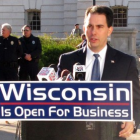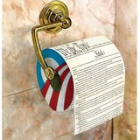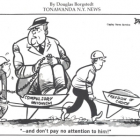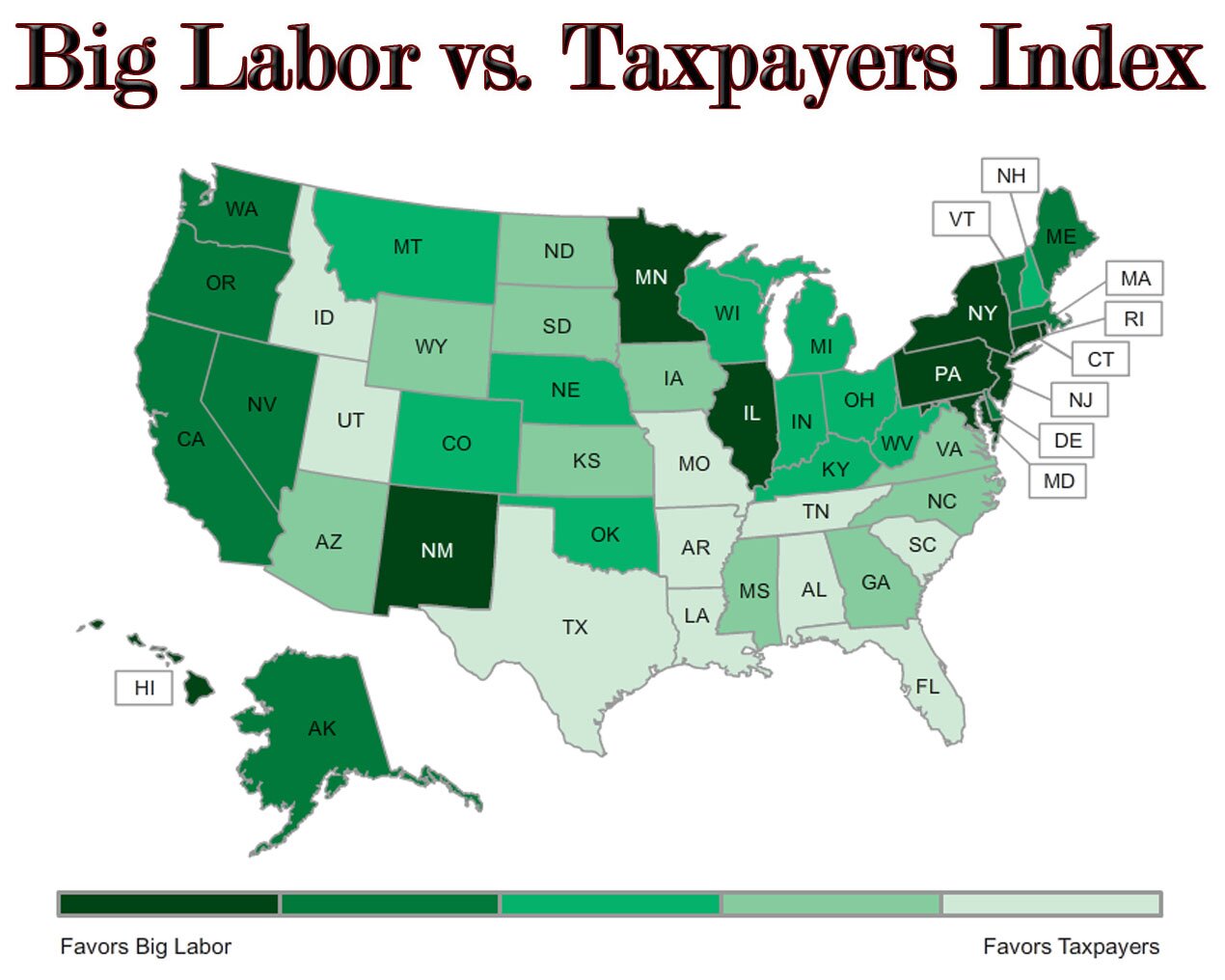Big Labor vs. Taxpayer: Detailed Information
X- Big Labor √- Taxpayer *- No Provision
The full index may be downloaded here

The Index includes scores on collective bargaining, broken into several subcategories:
- Paycheck protection laws;
- Open meetings laws;
- Government union density;
- Public employee pension underfunding;
- Right to work laws;
- Secret ballot protections and card check;
- Project labor agreements;
- Strike policy for government employees.
Collective Bargaining
Collective bargaining strengthens government unions’ labor monopoly in the public sector, manipulating the price and availability of public services. Big Labor uses the process of collective bargaining to exert control over budget and spending policy of state governments. Collective bargaining combined with political activity, enables unions to act as unelected government officials who lobby and negotiate for more government jobs and greater government employee pay and job security.
The gains that unions have made in the government sector are bankrupting states and municipalities. Government employees’ lavish compensation, unsustainable retirement benefits, and ironclad job security put enormous financial burdens on the taxpayer. Government workers, on average, earned 46 percent more in salary and benefits during the past decade than did similar workers in the private sector.
States that have long provided strong collective bargaining privileges to government employee unions today have high rates of union density and unsustainable pension liabilities. New Jersey, Massachusetts, Rhode Island, Connecticut, and New York all have union density rates of 55 percent or higher in the government sector. The high union density rates lead to some of the highest liabilities for government employee retirement funds.
Government employee unions’ are a relatively recent phenomenon. Until recently, even strong union advocates dismissed the notion of public sector unionism. President Franklin Delano Roosevelt once wrote, “All Government employees should realize that the process of collective bargaining, as usually understood, cannot be transplanted into the public service….The very nature and purposes of Government make it impossible for administrative officials to represent fully or to bind the employer in mutual discussions with Government employee organizations. The employer is the whole people, who speak by means of laws enacted by their representatives in Congress.”
Former AFL-CIO President George Meany put it more bluntly: “It is impossible to bargain collectively with the government.”
Points in the Big Labor versus Taxpayers Index are awarded to states that put taxpayer interests ahead of those of government employees in the following policy areas.
Paycheck Protection
Most of union bosses’ power comes from their ability to collect compulsory dues from employees in order for them to keep their jobs. The dues payments are used to lobby for union leaders’ preferred political agenda: bigger and more expansive government. For many union members, this means that their dues go to promote political agendas they do not support. Paycheck protection laws help to curb this undemocratic practice by requiring union bosses to obtain written consent from union members before they can use their dues for political activity.
Government employee unions’ spending is massive. The American Federation of State, County and Municipal Employees (AFSCME) was the largest outside spender in the 2010 election cycle. On its list of top all-time political donors, the Center for Responsive Politics lists AFSCME second. The National Education Association (NEA) fifth, the Service Employees International Union (SEIU) sixth, and the American Federation of Teachers (AFT) 10th. In short, government-sector unions constitute a permanent, well-funded, self-supporting lobby for bigger government, funded mostly from forced dues.
Points in the Big Labor versus Taxpayers Index are awarded to states that allow government employees to choose which political causes they want to support by requiring an op-in rather an op-opt mechanism for union political activities.
Secret Ballot Elections and Card Check
The secret ballot is a bedrock principle of democracy. The use of the secret ballot in union elections is paramount to maintaining employee rights. However, those rights are not protected like they are in elections for government officials. Big Labor’s preferred method of elections is card check. This circumvents the secret ballot by allowing a union to be certified for a group of workers by getting a majority of them to sign union cards. Card check occurs publically and usually in the presence of union organizers, which opens the door to coercion and intimidation.
Points in the Big Labor versus Taxpayers Index are awarded to states that have banned card check for government workers or instituted a Secret Ballot Protection Act for all workers.
Binding Arbitration
Binding arbitration is the process by which the unilateral decision of an unelected bureaucrat can determine the compensation and conditions of government employment. Some states mandate binding arbitration when collective bargaining negotiations reach an impasse. This policy usurps voters’ right to have the final say on how their state and local governments spend money.
Binding arbitration allows union negotiators to submit unreasonable offers in the hope that an arbitrator will make concessions to labor, as is often the case. In many cases elected officials have no power to overturn the arbitrator’s decisions, thus thwarting the electorate’s will.
Points in the Big Labor versus Taxpayers Index are awarded to states that allow elected officials, not unelected bureaucrats, to determine the cost of government employee compensation.
Open Meetings Laws
Open meetings laws give the public accessibility to government sector collective bargaining negotiations, in order to hold both union officials and state negotiators accountable to the taxpayer. By enforcing transparency, open meetings laws limit the harmful aspects of collective bargaining and binding arbitration.
An informed citizenry versed in the workings of government is needed to ensure the proper use of tax dollars. Currently, however, only 11 states provide access to government sector collective bargaining sessions. Our rankings show the variety of access to public meetings. The spectrum encompasses:
- Fully open meetings;
- Meetings where the government can restrict some access:
- Meetings where either party may restrict access:
- Closed meetings.
Points in the Big Labor versus Taxpayers Index are awarded to states to the degree to which they allow the public open access to labor negations.
Government Union Density
Government union density is the percentage of registered union members as a proportion of all employees. High government sector union density illustrates a highly active cycle of Big Labor political contributions to elected officials in exchange for more and bigger government and pro-union legislation designed to increase the numbers of dues-paying members.
Points in the Big Labor versus Taxpayers Index are awarded to states based on the percentage of their government workers who were unionized. More points are given to states with lower government union densities, which lead to greater savings and taxpayer control.
Public Employee Pension Underfunding
Pension underfunding is the amount each state government owes to fulfill its pension commitments to its employees. Collective bargaining, binding arbitration, and elected officials’ appeasement of union officials have led to an epidemic of unfunded state pension liabilities across the nation. According to a recent study by the Pew Center for the States. 31 states are below the 80-percent threshold needed for a pension system to be considered well funded. This debt directly affects taxpayer; as those states will require a tax increase of $1,000 or more to fully fund their pension systems if they make no other policy changes.
Points in the Big Labor versus Taxpayers Index are awarded to states based on their level of pension underfunding. Greater points are given to states that, by fully funding their pensions, do not burden future generations with having to pay for the retirement of today’s government workers.
Project Labor Agreement Bans
Project labor agreements (PLAs) are government construction contracts steered to unionized construction firms. This practice eliminates fair and open competition. Under a PLA, a construction firm must agree to sign a union collective bargaining agreement, whether it is unionized or not, before it can bid on a government construction project. PLAs cost taxpayers. They can increase government construction costs by up to 18 percent.
Points in the Big Labor versus Taxpayers Index are awarded to states that have banned PLAs, thus putting taxpayer savings ahead of favors to Big Labor.
Strike Policy
Strike policy indicates the rights of government employees to strike in each state. Government sector unions’ right to strike is detrimental to the free flow of commerce and maintenance of public services. Strike policies allow union officials to hold the taxpayer hostage by threatening the withdrawal of essential government services. When public safety employees are allowed to strike it endangers all citizens. This allows the union to gain generous concessions from government officials that end up creating unsustainable contracts which often lead to state budget strains.
Points in the Big Labor versus Taxpayers Index are awarded to states that do not allow strikes by government workers.
All data points used for the index as well as all works referenced can be found in a detailed spreadsheet available here.
For inquiries on the index, contact CEI Labor Policy Counsel F. Vincent Vernuccio at or . Created by Trey Kovacs and F. Vincent Vernuccio.
References:
- Novy-Marx, Robert, and Joshua D. Rauh. The Revenue Demands of Public Employee Pension Promises. Rep. National Bureau of Economic Research, 2011. Print.
- Valletta, Robert G., and Richard B. Freeman. The NBER Public Sector Collective Bargaining Law Data Set. Rep. National Bureau of Economic Research. Print.
- Norcross, Eileen. Public Sector Unionism: A Review. Working paper. Vol. No. 11-26. Mercatus Center. Print.
- Unionstats.com
- http://www.aflcio.org/joinaunion/voiceatwork/efca/upload/multistate_efca051409.pdf
- http://www.pewcenteronthestates.org/initiatives_detail.aspx?initiativeID=85899358839
 Wrong way, Illinois: Unemployment rate increased most in the nation in 2011
Wrong way, Illinois: Unemployment rate increased most in the nation in 2011
 Wisconsin union holding federal funds hostage
Wisconsin union holding federal funds hostage


 Governor Dayton’s Baleful Influence on Labor Relations
Governor Dayton’s Baleful Influence on Labor Relations

